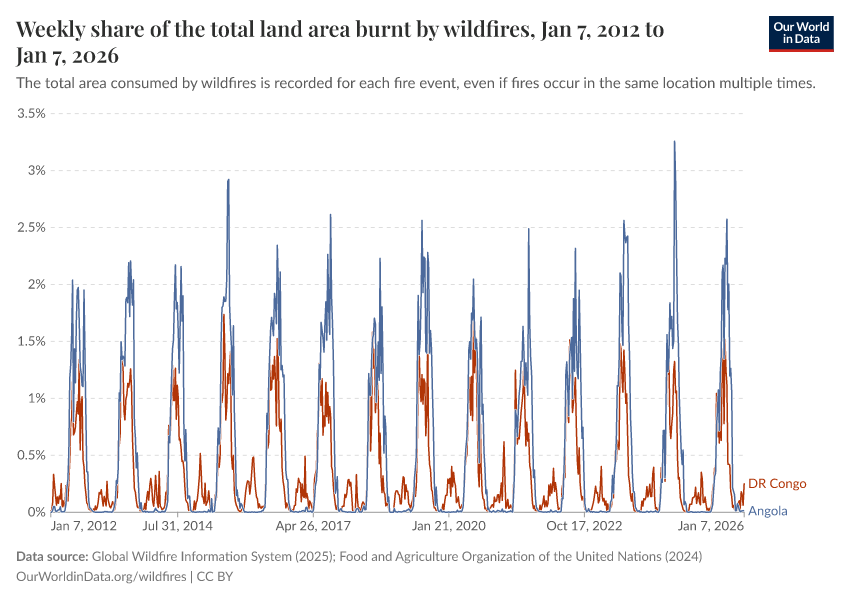Weekly share of the total land area burnt by wildfires

What you should know about this indicator
- Wildfires are detected through the use of satellite imagery obtained from MODIS (Moderate Resolution Imaging Spectroradiometer) and VIIRS (Visible Infrared Imaging Radiometer Suite). These satellite systems are capable of identifying thermal anomalies and alterations in landscape patterns, which are indicative of burning.
- The data provider is presently engaged in a global accuracy assessment and acknowledged that they might be underestimating the genuine impact of wildfires, primarily due to constraints imposed by the spatial resolution of the sensors they employ.
What you should know about this indicator
- Wildfires are detected through the use of satellite imagery obtained from MODIS (Moderate Resolution Imaging Spectroradiometer) and VIIRS (Visible Infrared Imaging Radiometer Suite). These satellite systems are capable of identifying thermal anomalies and alterations in landscape patterns, which are indicative of burning.
- The data provider is presently engaged in a global accuracy assessment and acknowledged that they might be underestimating the genuine impact of wildfires, primarily due to constraints imposed by the spatial resolution of the sensors they employ.
Sources and processing
This data is based on the following sources
How we process data at Our World in Data
All data and visualizations on Our World in Data rely on data sourced from one or several original data providers. Preparing this original data involves several processing steps. Depending on the data, this can include standardizing country names and world region definitions, converting units, calculating derived indicators such as per capita measures, as well as adding or adapting metadata such as the name or the description given to an indicator.
At the link below you can find a detailed description of the structure of our data pipeline, including links to all the code used to prepare data across Our World in Data.
Notes on our processing step for this indicator
The share of the total land area burnt by wildfires is calculated by dividing the area burnt by wildfires by the total land area of the country.
Reuse this work
- All data produced by third-party providers and made available by Our World in Data are subject to the license terms from the original providers. Our work would not be possible without the data providers we rely on, so we ask you to always cite them appropriately (see below). This is crucial to allow data providers to continue doing their work, enhancing, maintaining and updating valuable data.
- All data, visualizations, and code produced by Our World in Data are completely open access under the Creative Commons BY license. You have the permission to use, distribute, and reproduce these in any medium, provided the source and authors are credited.
Citations
How to cite this page
To cite this page overall, including any descriptions, FAQs or explanations of the data authored by Our World in Data, please use the following citation:
“Data Page: Weekly share of the total land area burnt by wildfires”, part of the following publication: Hannah Ritchie, Pablo Rosado, and Veronika Samborska (2024) - “Climate Change”. Data adapted from Global Wildfire Information System, Food and Agriculture Organization of the United Nations. Retrieved from https://archive.ourworldindata.org/20251212-095432/grapher/weekly-share-of-the-total-land-area-burnt-by-wildfires.html [online resource] (archived on December 12, 2025).How to cite this data
In-line citationIf you have limited space (e.g. in data visualizations), you can use this abbreviated in-line citation:
Global Wildfire Information System (2025); Global Wildfire Information System (2024); Food and Agriculture Organization of the United Nations (2024) – with minor processing by Our World in DataFull citation
Global Wildfire Information System (2025); Global Wildfire Information System (2024); Food and Agriculture Organization of the United Nations (2024) – with minor processing by Our World in Data. “Weekly share of the total land area burnt by wildfires” [dataset]. Global Wildfire Information System, “Seasonal wildfire trends”; Food and Agriculture Organization of the United Nations, “Land, Inputs and Sustainability: Land Use” [original data]. Retrieved December 23, 2025 from https://archive.ourworldindata.org/20251212-095432/grapher/weekly-share-of-the-total-land-area-burnt-by-wildfires.html (archived on December 12, 2025).